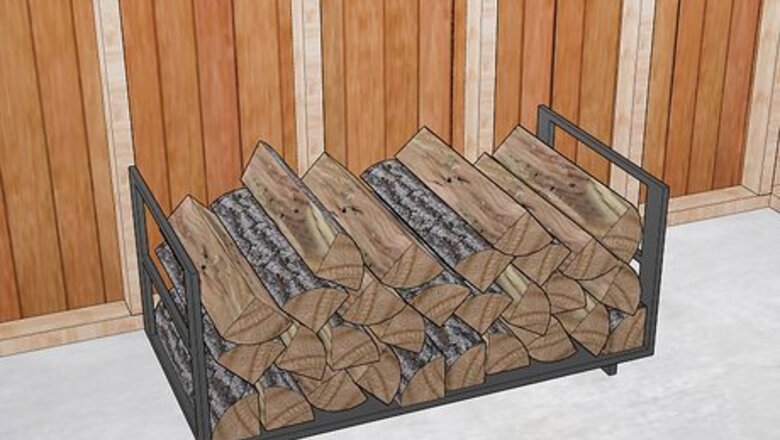
views
- Keep the firewood off of the soil since direct exposure to dirt will cause the wood to rot slowly.
- A non-wood shed is ideal when it comes to keeping your firewood clean and dry.
- Stack your firewood in the same direction to encourage air circulation, which will keep the wood moisture-free.
- Cover the wood with a clean tarp when you’re not using it to keep it dry and safe.
Selecting a Storage Location
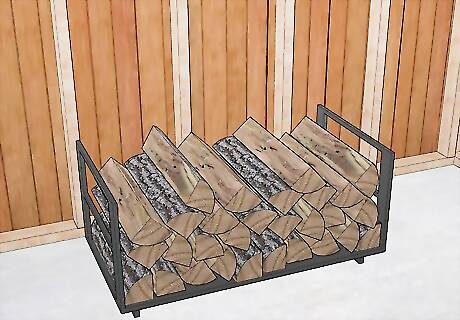
Seek out a location close to your home. When storing firewood, it's important to keep convenience in mind. Firewood can be heavy to carry from outside into your home, and this can be especially stressful during the colder months. Seek out an appropriate space away from the home to avoid infestations from termites and carpenter ants, but nearby enough for convenience. Keep in mind, if there aren't any appropriate spaces very close to your home, you can invest in a wheelbarrow to make transferring the firewood easier.
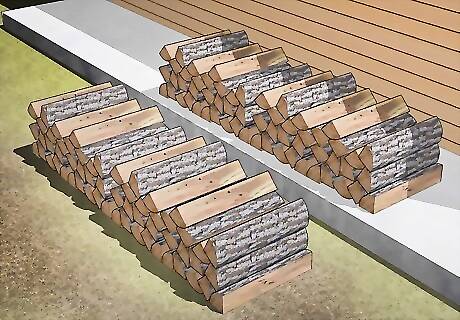
Find a location off of soil. When firewood is stored directly on the ground, it will rot quicker. Bacteria and bugs can get into the firewood, causing it to go bad. Look for a place off of soil. Surfaces like concrete, asphalt, and clean gravel can be good surfaces for firewood. If you can't find any appropriate surfaces, you can use sticks to elevate firewood off of the ground. You can also lay down a tarp underneath firewood.
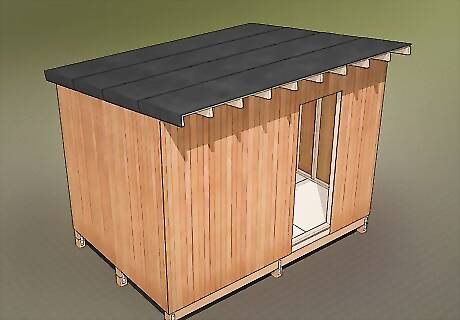
See if there's room in an outdoor non-wooden storage shed. If you have an outdoor storage shed, this a great place to store firewood. Inside a shed, firewood will be protected from things like rain. The shed will also provide a barrier between firewood and the soil. If possible, store firewood in an outdoor shed. Be careful of termites and carpenter ants taking up a home in wooden sheds as they can cause significant structural damage. You can also store firewood in your garage.

It is never recommended to store firewood inside homes. Bugs, including termites and carpenter ants, can hitch a ride on the wood and cause significant property damage to wooden structures. You can store firewood in an old trunk, if you have one. Some fireplaces have compartments built into the wall next to them where you can store firewood. Make sure firewood you store indoors is fully dry. If you chopped or collected your own firewood, you should store it outside until it dries. It takes firewood around six months to fully dry out.
Storing Your Firewood Safely
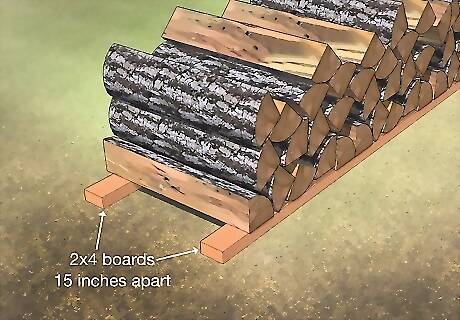
Elevate firewood with 2 by 4 or 4x4 pressure treated boards, if necessary. If you can't find an area outdoors off of the soil, you can easily elevate firewood using 2 by 4 boards. You can buy boards at any hardware store and create a quick storage area for your firewood. Lay the boards on the ground about 15 inches apart. Lay down as many rows of boards as you need to stack all your firewood. Lay your firewood over the boards, keeping them parallel to the boards. The boards should elevate the firewood off the ground slightly, preventing it from touching the soil. EXPERT TIP Sina Kamran Sina Kamran Hardscape Specialist Sina Kamran is a Hardscaping Specialist and the Owner of Design Scapes, Inc. in Santa Monica, California. With over 15 years of experience, he specializes in customized, site-specific hardscaping and landscaping design/build projects. He's a certified National Concrete Masonry Association (NCMA) designer, a certified installer with the Interlocking Concrete Pavement Institute (ICPI), and a Rain Bird Certified Irrigation Professional. Additionally, Design Scapes, Inc. has many 5-star rated reviews. Sina Kamran Sina Kamran Hardscape Specialist Protecting firewood from weather and bugs is easy with a simple wood rack made from cinder blocks and wood. Protecting firewood from weather and bugs is easy and cheap. Make a rack with just 2 cinder blocks and 6 pieces of wood without any tools. This keeps the wood dry and insect-free. It also neatly organizes your supply in a DIY project that takes no time.
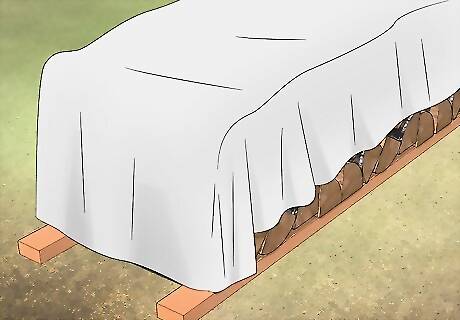
Use a tarp to protect your firewood from moisture. You should always lay a tarp down over your firewood. You can buy a tarp at any hardware store. Simply lay the tarp over the firewood and tie it down to secure it. You can also weigh the tarp down with something like bricks. It's important to allow for some air circulation, as you don't want your firewood to get too dry. You should leave the sides of your stack open to allow for airflow.
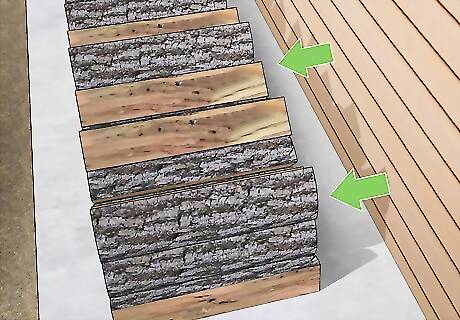
Stack firewood effectively. When stacking firewood, make sure to do so effectively. Stacking your firewood incorrectly can cause it to rot quicker. You should always stack your firewood rather than throwing it in a pile. This will promote air circulation and keep firewood from drying out. Never stack firewood against a wall when stacking it outdoors. This can leave firewood vulnerable to moisture and bacteria. Always leave a few inches of space between your firewood and a wall. Never place firewood against the side of a wooden structure, including your house, because this will invite termites and carpenter ants to feast on your home.
Avoiding Pitfalls

Do not put a tarp over firewood before it's dry. Wet firewood needs to dry out before it can be stored safely. Wet wood needs to be exposed to open air to dry out. If you've just collected firewood, refrain from putting a tarp over it. If it's going to rain, it's appropriate to cover wet firewood with a tarp. Just make sure to leave the sides of firewood pile uncovered.
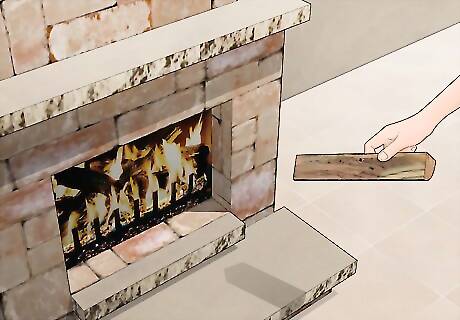
Makes sure your firewood is ready before using it. You do not want to throw wet firewood into your fireplace. Before using your firewood, make sure it's adequately dry. Dry firewood will be gray with cracks along the edges. Dry firewood will also be much lighter than wet firewood.
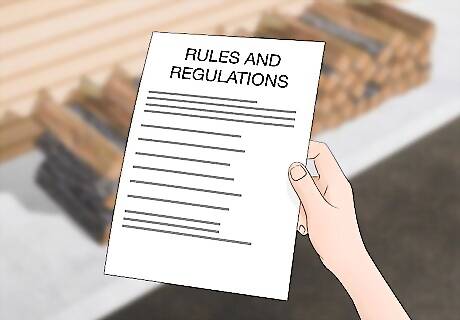
Check any local regulations regarding firewood storage. It's possible your city or neighborhood may have regulations about storing firewood. Look over local codes in your area before choosing a storage method for your firewood. You want to make sure you store your firewood legally.



















Comments
0 comment